| dc.contributor.advisor | Rosas Bazán, Rudy José | |
| dc.contributor.author | Huaylla Salomé, Miguel Angel | |
| dc.date.accessioned | 2022-11-24T20:44:59Z | |
| dc.date.available | 2022-11-24T20:44:59Z | |
| dc.date.created | 2022 | |
| dc.date.issued | 2022-11-24 | |
| dc.identifier.uri | http://hdl.handle.net/20.500.12404/23842 | |
| dc.description.abstract | Las superficies pseudo-esféricas tienen localmente la misma geometría que H2,
además podemos obtener una realización (inmersión isométrica) de un horodisco de H2 en la pseudo-esfera. ¿Se podrá realizar todo H2 en R3 como una superficie
sin singularidades? ¿Existe alguna variedad completa con curvatura constante
negativa que se pueda realizar en R3? Una respuesta negativa lo da el teorema
de Hilbert. ¿Es realmente esencial que la curvatura sea constante como hipótesis
en este teorema? ¿Es posible dilatar las hipótesis de este teorema de modo que la
conclusión siga siendo válida? Encontraremos las respuestas a estas preguntas en
el teorema de Efimov. ¿Existirá algún entero p tal que H2 pueda realizarse en Rp?
¿La respuesta a la pregunta anterior se puede generalizar para Hn? Como último
objetivo de este trabajo, es estudiar a detalle el teorema de Blanusa quien logra
responder a estas preguntas, de manera afirmativa. Posteriormente Rozendorn,
Henke-Nettekoven y Azov, reducieron la codimensión de estas realizaciones,
haciendo uso del método planteado por Blanusa el cual será expuesto a detalle. | es_ES |
| dc.description.abstract | The pseudo-spherical surfaces locally have the same geometry as H2, furthermore we can obtain a realization (isometric immersion) of a horodisk of H2 in the pseudo-sphere. Will all H2 in R3 be realized as a surface without singularities? Is there a complete manifold with constant negative curvature that can be realized on R3? A negative answer is given by the Hilbert's theorem. Is it really essential that the curvature be constant as an assumption in this theorem? Is it possible to weaken the hypotheses of this theorem so that the conclusion holds? We will find the answers to these questions in Efimov's theorem. Will there exist some integer p such that H2 can be realized in Rp? Can the answer to the previous question be generalized to Hn? As the last objective of this work, it is to study in detail the Blanusa theorem who manages to answer these questions, in an afirmative way. Subsequently, Rozendorn, Henke-Nettekoven and Azov reduced the codimension of these realizations, using the method proposed by Blanusa, which will be explained in detail. | es_ES |
| dc.language.iso | spa | es_ES |
| dc.publisher | Pontificia Universidad Católica del Perú | es_ES |
| dc.rights | info:eu-repo/semantics/openAccess | es_ES |
| dc.rights | Atribución 2.5 Perú | * |
| dc.rights.uri | http://creativecommons.org/licenses/by/2.5/pe/ | * |
| dc.subject | Proyección isométrica | es_ES |
| dc.subject | Curvatura | es_ES |
| dc.subject | Superficies | es_ES |
| dc.subject | Variedades (Matemáticas) | es_ES |
| dc.title | Inmersiones isométricas de variedades completas con curvatura negativa en espacios euclidianos | es_ES |
| dc.type | info:eu-repo/semantics/masterThesis | es_ES |
| thesis.degree.name | Magíster en Matemáticas | es_ES |
| thesis.degree.level | Maestría | es_ES |
| thesis.degree.grantor | Pontificia Universidad Católica del Perú. Escuela de Posgrado | es_ES |
| thesis.degree.discipline | Matemáticas | es_ES |
| renati.advisor.dni | 40037412 | |
| renati.advisor.orcid | https://orcid.org/0000-0002-4740-389X | es_ES |
| renati.author.dni | 72764567 | |
| renati.discipline | 541137 | es_ES |
| renati.juror | Figueroa Serrudo, Christiam Bernardo | es_ES |
| renati.juror | Rosas Bazán, Rudy José | es_ES |
| renati.juror | Rabanal Montoya, Roland | es_ES |
| renati.level | https://purl.org/pe-repo/renati/level#maestro | es_ES |
| renati.type | https://purl.org/pe-repo/renati/type#tesis | es_ES |
| dc.publisher.country | PE | es_ES |
| dc.subject.ocde | https://purl.org/pe-repo/ocde/ford#1.01.00 | es_ES |






